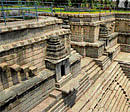
Badami, Pattadkal and Aihole make it to the top of any tourist’s list but Lakkundi, which is nearby and historically relevant to the aforementioned places, is the one place most tourists ignore.
Lakkundi (Lokki-gundi or Loku-gundi) is a small village located 12 km south-east of Gadag on the Hubli-Hospet Highway (NH-63). The village is full of ruined temples and tanks, a few of which have been restored and maintained by the ASI. Lakkundi has temples and inscriptions spread over the period of Kalyani Chalukyas, Kalachuris, Sevunas and Hoysalas.
Historical perspective
The Chalukyas ruled from Kalyana (present Basavakalyana) in Bidar district from the 10th century to 12th century CE after defeating the Rashtrakutas. Taila II was the founder of this dynasty and claimed descent from the Chalukyas of Badami (who are famous for the monuments at Badami, Pattadkal and Aihole). The Kalyana Chalukyas were great patrons of art and built glorious temples and tanks at Itagi, Lakkundi, Kuruvatti, Gadag, etc.
Lakkundi gained prominence in the medieval period. In the 11th century, it was a centre of higher learning and an eminent agrahara. This place was also a busy centre for mintage. The great Hoysala king Vira Ballala resided here and made Lakkundi his second metropolis. It was at Lakkundi that Kalyana Chalukya architecture reached its zenith.
There are many temples of varying floor plans and elevation. Greenish blue schist (soap stone) was the chief raw material used here unlike Aihole and Pattadkal where sandstone was used. Brahma Jinalaya, Kashivishveshwara, Kumbareshwara, Manikeshwara, Naganatha, Nanneshwara and Musukinabaavi are some of the monuments being protected and maintained by the ASI. The ASI has proposed that this group of monuments be enlisted as World Heritage monuments.
The most detailed and magnificent temple in Lakkundi is the Kashivishveshwara temple.
It is actually a twin temple built over a common plinth and has two sanctums, one has a Shiva linga while the other one housed a Surya statue. Many themes from Badami, Pattadkal and Aihole are repeated here but are depicted much more intricately. The painstakingly carved multi-banded door-jambs are breathtaking. The Brahma Jinalaya is another notable monument. The most remarkable sculpture is that of the four-faced Brahma himself. The idol in the sanctum is that of Neminatha. The Musukina baavi is an ornate stepped well. It has a flight of steps leading to water on the southern, eastern and western sides. Over the flight of steps on the southern side is a double -storied mantapa. The well-maintained gardens add to the glory of this place. There is a Manikeshwara temple near the tank. The tank is artistically built with small canopied niches inside the walls of the well enshrining lingas.
The Jaina temple complex houses over 250 epigraphs, statues and carved architectural members.
The most remarkable thing is that the caretakers of all the places mentioned above are very friendly and well versed in the history of the place and also have some interesting stories to tell. You just have to lend them a patient ear.
I was impressed by the story of Dana Chintamani Attimabbe among the others.
Attimabbe was the wife of Nagadeva, an officer under Taila II.
She built the Brahma Jinalaya, a landmark in Jain architecture. She donated 1,500 jewel-studded statues of thirthankaras and 1,000 copies of the manuscript of Ponna’s ‘Santipurana’. She also patronised the great Kannada poet Ranna.
She walked all the way to Shravanabelagola without drinking a drop of water or eating a morsel of food!